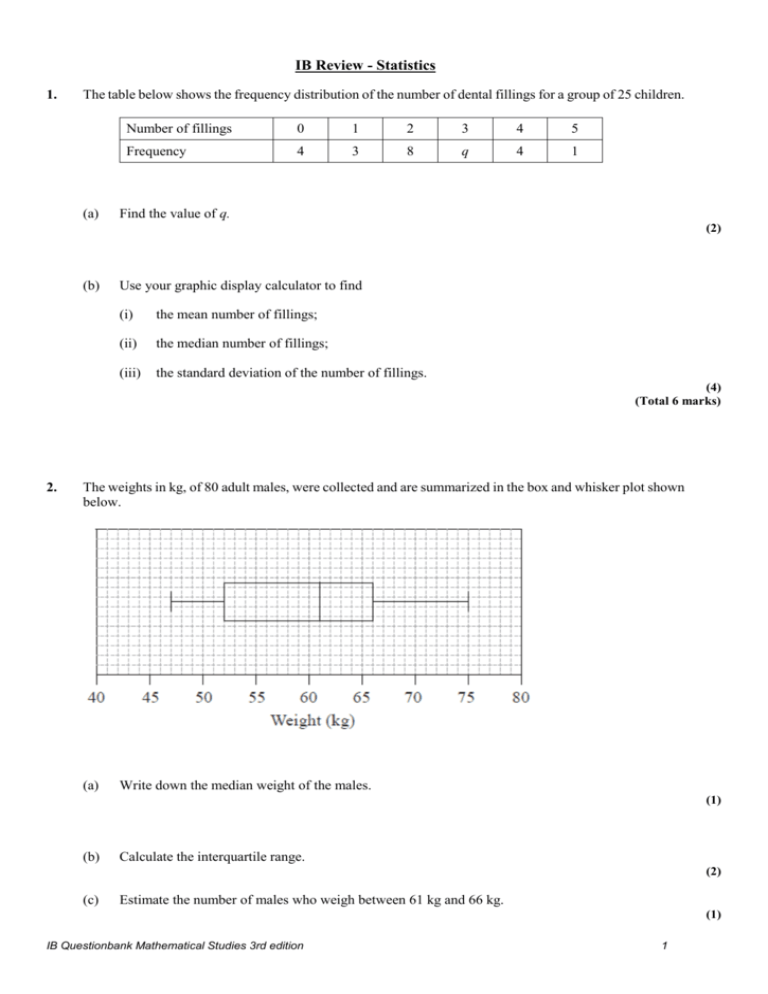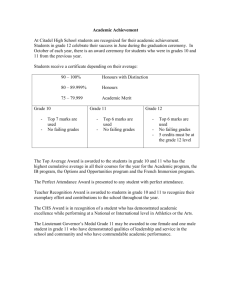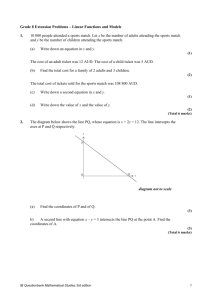IB Review – Stats
advertisement

IB Review - Statistics 1. The table below shows the frequency distribution of the number of dental fillings for a group of 25 children. (a) Number of fillings 0 1 2 3 4 5 Frequency 4 3 8 q 4 1 Find the value of q. (2) (b) Use your graphic display calculator to find (i) the mean number of fillings; (ii) the median number of fillings; (iii) the standard deviation of the number of fillings. (4) (Total 6 marks) 2. The weights in kg, of 80 adult males, were collected and are summarized in the box and whisker plot shown below. (a) Write down the median weight of the males. (1) (b) Calculate the interquartile range. (2) (c) Estimate the number of males who weigh between 61 kg and 66 kg. (1) IB Questionbank Mathematical Studies 3rd edition 1 (d) Estimate the mean weight of the lightest 40 males. (2) (Total 6 marks) 3. 120 Mathematics students in a school sat an examination. Their scores (given as a percentage) were summarized on a cumulative frequency diagram. This diagram is given below. IB Questionbank Mathematical Studies 3rd edition 2 (a) Complete the grouped frequency table for the students. Examination Score x (%) Frequency 0 ≤ x ≤ 20 20 < x ≤ 40 14 26 40 < x ≤ 60 60 < x ≤ 80 80 < x ≤ 100 (3) (b) Write down the mid-interval value of the 40 < x ≤ 60 interval. (1) (c) Calculate an estimate of the mean examination score of the students. (2) (Total 6 marks) IB Questionbank Mathematical Studies 3rd edition 3 4. The cumulative frequency graph shows the amount of time in minutes, 200 students spend waiting for their train on a particular morning. (a) Write down the median waiting time. (1) (b) Find the interquartile range for the waiting time. (2) IB Questionbank Mathematical Studies 3rd edition 4 The minimum waiting time is zero and the maximum waiting time is 45 minutes. (c) Draw a box and whisker plot on the grid below to represent this information. (3) (Total 6 marks) 5. The mean of the ten numbers listed below is 6.8. 8, 5, 5, 10, 8, 4, 9, 7, p, q (a) Write down an equation in terms of p and q. (2) The mode of these ten numbers is five and p is less than q. (b) Write down the value of (i) p; (ii) q. (2) (c) Find the median of the ten numbers. (2) (Total 6 marks) IB Questionbank Mathematical Studies 3rd edition 5 6. The weights of 90 students in a school were recorded. The information is displayed in the following table. (a) Weight (kg) Number of students 40 ≤ w < 50 7 50 ≤ w < 60 28 60 ≤ w < 70 35 70 ≤ w < 80 20 Write down the mid interval value for the interval 50 ≤ w < 60. (1) (b) Use your graphic display calculator to find an estimate for (i) the mean weight; (ii) the standard deviation. (3) (c) Find the weight that is 3 standard deviations below the mean. (2) (Total 6 marks) 7. Eight houses in a street are inhabited by different numbers of people, as shown in the table below. House A B C D E F G H Number of inhabitants 5 4 7 6 4 3 6 4 IB Questionbank Mathematical Studies 3rd edition 6 (a) The following statements refer to the number of inhabitants per house. Write down true (T) or false (F) for each. (i) The mean is 5. (ii) The range is 4. (iii) The mode is 6. (iv) The standard deviation is 1.4 correct to 2 significant figures. (4) (b) Calculate the interquartile range for the number of inhabitants per house. (2) (Total 6 marks) SOLUTIONS 1. (a) q = 25 – (4 + 3 + 8 + 4 + 1) (M1) Note: Award (M1) for subtraction from 25 of all values from the table. =5 (b) (A1) (C2) (i) 2.2 (ii) 2 (iii) 1.39 (A2)(ft) (C2) Note: Award (M1) for use of mean formula with correct substitution. Follow through from part (a), irrespective of whether working is shown. (A1) (C1) (A1)(ft) (C1) Note: Follow through from part (a), irrespective of whether working is shown. Award (A1)(AP) for 1.38. [6] 2. Unit penalty applies in parts (a) and (d) UP (a) 61 kg (b) 66 – 52 = 14 (c) 20 (A1) (C1) (A1) (A1)(ft) (C2) Note: Award (A1) for identifying quartiles, (A1)(ft) for correct subtraction of their quartiles. IB Questionbank Mathematical Studies 3rd edition (A1) (C1) 7 (d) UP 49.5 20 56.5 20 (M1) 40 Note: Award (M1) for multiplication of midpoints by frequencies. = 53 kg (A1) (C2) [6] 3. (a) % 0–20 20–40 40–60 60–80 80–100 F 14 26 58 16 6 (A1)(A1)(A1) (C3) (b) 50 (c) Mean = = 45 (A1) (C1) 2 3 10 14 ....... 90 6 (M1) 120 Note: Award (M1) for correct substitution of their values from (a) in mean formula. (45.7) (A1)(ft) (C2) [6] 4. Unit penalty applies in part (a) UP (a) Median = 25 mins (b) 32 – 16 = 16 (A1) (C1) (A1) (A1)(ft) (C2) Notes: Award (A1) for identifying correct quartiles, (A1)(ft) for correct answer to subtraction of their quartiles. IB Questionbank Mathematical Studies 3rd edition 8 (c) median shown (A1)(ft) box with ends at their quartiles (A1)(ft) end points at 0 and 45 joined to box with straight lines (A1) (C3) Note: Award (A1)(ft)(A1)(ft)(A0) if lines go right through the box. [6] 5. (a) (b) (c) 8 5 5 10 8 4 9 7 p q = 6.8 or equivalent (M1)(A1) (C2) 10 Note: Award (M1) for correct substituted mean formula, (A1) for correct substitution. (i) p=5 (ii) q=7 7 (A1)(ft) (A1)(ft) (C2) Note: Follow through from their answers to parts (a) and (b) (i). (M1)(A1)(ft) (C2) Notes: Award (M1) for an attempt to order their numbers. Follow through from their answers to parts (b)(i) and (ii). [6] 6. (a) 55 (i) (A1) (C1) 62.5 (62.6) IB Questionbank Mathematical Studies 3rd edition (A2)(ft) (C2) 9 (ii) 8.86 (A1) (C1) Note: Follow through from their answer to part (a). (c) 62.6 – 3 × 8.86 = 36.0 (M1)(A1)(ft) (C2) Note: Accept 36. Follow through from their values in part (b) only if working is seen. [6] 7. (a) (b) (i) F (A1) (ii) T (A1) (iii) F (A1) (iv) F (A1) (C4) IQR = 6 – 4 (M1) Note: Award (M1) for identifying correct quartiles. IQR = 2 (A1)(ft) (C2) [6] IB Questionbank Mathematical Studies 3rd edition 10






